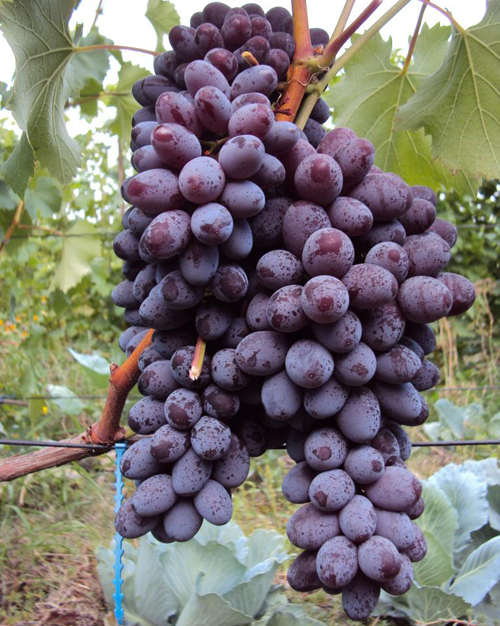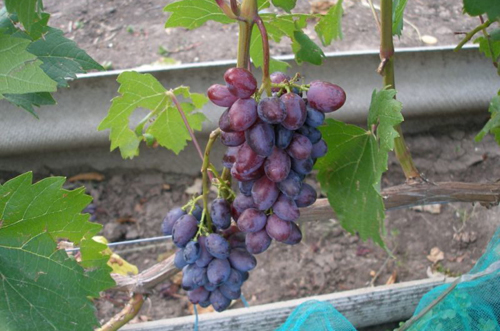Jupiter grape variety
The seedless grape variety Jupiter is a relatively new inhabitant of the plots of amateur winegrowers in our country. Until recently, it seemed exotic at all, causing distrust and skepticism among many, but the successful test by the pioneers, and the wonderful properties that it demonstrated at the same time, made it quite popular and widespread.
The homeland of our hero is the United States, where he was born at the University of Arkansas, becoming the fourth seedless interspecific hybrid, a selection of this scientific and educational institution. Its predecessors in the series were Venus, Mars and Saturn. Jupiter was obtained by crossing two promising hybrid forms, Arkansas 1258 and Arkansas 1672, produced in 1981. The pedigree of the parents stretches from the samples of the European cultural grapes Vitis vinifera, which passed on to the descendant the genes for large-fruited, excellent taste and nutmeg aroma, and on the father's side - from the old American raisin variety Glenor, whose DNA also contains the resistance inherent in grape species from the New World. The seeds from this controlled hybridization germinated in a greenhouse in the winter of 1981-82. The seedlings were planted outdoors in the spring of 1982 at the university fruit substation in Clarksville. According to the results of fruiting in 1984, one of them was selected due to an attractive set of qualities - seedlessness, nutmeg aroma of berries and good appearance of bunches, after which the hybrid was given the working name Arkansas 1985. It received its current name after passing tests in 1998 th year. Jupiter was authored by John R. Clark and James N. Moore. The variety is officially patented in its homeland.

The grapes are distinguished by good resistance to diseases and pests, which was a consequence of the presence in its DNA of genes of the American species Vitis labrusca, however, unlike simple interspecific hybrids, the specific labrus aroma is not felt at all in the taste of the berries. Instead, there is an exquisite nutmeg, and absolutely nothing in the taste betrays an insufficiently aristocratic origin of the variety. In addition, from the positive qualities of Jupiter, one can single out high plasticity, resistance to frost and an early ripening period, which significantly expand the geography of its growth, and, of course, excellent yield. The main drawback, which the authors themselves admit, is the low drought resistance, especially on light permeable soils, where it is very desirable to carry out additional watering.
Agrobiological characteristics
The bushes are not very vigorous. The crown of a young shoot is light green, with a bright red border, covered with dense, light-colored pubescence. Vine leaves are large, rounded or slightly stretched in width, five-lobed, slightly dissected, rich green. Lateral notches barely marked or absent. The petiole notch is open, wide, vaulted with a pointed bottom. The petioles on a fully developed leaf are green, sometimes with a slight pink tinge, 11-12 cm long. The denticles are medium-sized at the edge of the leaf, triangular with a wide base, convex sides and sharp tops. The surface of the leaf is reticulate-wrinkled, the reverse side between the veins is covered with light pubescence. The flowers are bisexual, perfectly pollinated. The size of the inflorescence is on average 12.5 cm in length and 7.5 in width. The shape of the inflorescence is conical, sometimes with a wing. The variety does not show a tendency to pea.

Bunches of Jupiter are medium in size, weighing 200-300 grams, conical or cylindrical-conical in shape, rather dense. The number of berries in a bunch is 48-61. The number of clusters on an adult bush is 75-151. The comb is short, up to 5 cm long, easily detached from the vine during harvest; the legs of the berries are strong.The berries are large enough, with an average weight of 5.5 grams, slightly oblong in shape and very uniform in size. Ripe grapes are reddish blue in color. The pulp is greenish-yellow, juicy-fleshy, sweet, of pleasant taste with an exquisite nutmeg aroma. The juice of the variety is not colored, its sugar content is quite high and is 20-21 grams / 100 ml, while the acidity is 5-7 grams / liter. The skin is thin, but firm, combined with the pulp, eaten, covered with a gray waxy coating. The seeds are practically absent in the berry. There are only rudimentary inclusions, and only in very rare cases can the bone develop completely. The class of seedlessness is the second. For several weeks after ripening, the bunches can continue to hang on the bush, while the strength of the connection between the berries and the cluster does not weaken and the grapes do not crumble. You should not do this only in extremely hot weather, as the berries can begin to lose moisture and become rainy. The grapes are resistant to cracking under unfavorable ripening conditions.
The crop is intended for fresh consumption, use in confectionery, cooking, canning and drying for raisins. Jupiter's tasting ratings are very high due to the pleasant pulp consistency, taste, aroma and the absence of seeds in the berry. Good transportability and keeping quality of grapes allow it to be transported over long distances without damage and stored in refrigerated chambers for quite a long time.

The ripening period of the bunches is early, with a vegetation period from bud opening to the onset of removable ripeness of 110-115 days and the sum of active temperatures required for ripening, 2350-2450 ° C. With such indicators, our hero is able to ripen in all areas of the central black earth zone of the Russian Federation and even slightly to the north. At the same time, the frost resistance of the variety is increased (-23 ... -25 ° С), but still insufficient for a non-covering crop in the northern regions of cultivation.
The yield of Jupiter shows phenomenal - 20-30 kilograms per bush is not the limit for him. In the homeland of grapes, in the USA, advanced farms achieve fantastic results with good agricultural technology, favorable climatic conditions and drip irrigation - 25-29 t / ha.
The average number of clusters per fruitful shoot is about two, and the plant is ready to provide all of them with the food necessary for the ripening of the clusters. With sufficient and competent care, the bushes “pull out” even the most abundant harvest, reacting to overload only with a delay in ripening. This, of course, does not mean that overloading can be tolerated from year to year, because it inevitably leads to the weakening of the plants themselves, which, after a series of such tests, can simply die in winter.
Agrotechnical features
Our American hero also demonstrates excellent characteristics in terms of unpretentiousness, endurance to unfavorable growing conditions and mistakes made during its cultivation. Most of the most harmful diseases of grapes, such as powdery mildew (powdery mildew), anthracnose, black and gray rot, Jupiter does not care at all. It demonstrates insufficient resistance only to downy mildew (mildew), but its spread is easily controlled by available and approved systemic and contact fungicides. Resistance to phylloxera in the variety has not been reliably established, and therefore its planting in the zones of its distribution is recommended only by grafted seedlings. Own-rooted culture is permissible only where phylloxera is absent. Harvest damage by pests, including wasps, is quite rare.
It is necessary to form a bush taking into account the minimum winter temperatures characteristic of the place of growth.In regions with mild winters, where there is no risk of frost damage to bushes, Jupiter is grown without shelter, forming a tall trunk with powerful lateral arms. Where such a risk exists, it is worth taking seriously the shelter of vines for the winter, and therefore the plants themselves should be formed according to schemes convenient for this. In particular, a variety of squat formations are convenient, the most popular of which are the multi-arm fan, and the oblique (inclined) cordon. An intermediate option is also possible, when the main part of the grape bush is formed on a high non-covering trunk, and a lightweight lower tier is created closer to the ground, which is sheltered for the winter. In case of death of the uncovered part from frost, with the help of a reserve, it will be possible to quickly restore the plant to its original state.
Jupiter, who is prone to crop overload, necessarily needs to regulate the load in order to avoid negative consequences for the viability of the variety. This is done mainly during spring pruning, since thinning out numerous relatively small bunches is a rather troublesome and troublesome business. An average of 35-40 eyes are left on the bush in the spring, with a pruning length of at least 7-9 buds. Comparatively long fruiting arrows are necessary, since the lower buds are less fruitful than the upper ones.
When growing Jupiter, special attention should be paid to the balance of soil nutrition and moisture supply of plants. The high productivity of the plantations also determines the high demand for water and nutrients. Grapes should not be placed on poor, dry sandy soils, and even on relatively fertile soils, you should not underestimate the benefits of fertilizing with moderate doses of fertilizers and regular watering.
In addition to standard agrotechnical operations, the variety, like many of its seedless cousins, responds well to the use of the gibberellin growth stimulator. The brushes treated with it during the flowering period form larger berries, which further increases the mass yield indicators. And such an event has a more than positive effect on the quality of berries, in particular, even the rudiments of seeds are practically not formed in them.
All of the above makes Jupiter a stunningly successful grape variety that has already been appreciated by many winegrowers around the world. If you also want to grow real raisins with your own hands, without making excessive efforts and special skills for this, then this variety is undoubtedly for you.









This is a variety that will not disappear from my site under any circumstances. At first, one seedling was planted more for trial, so to speak. But after the first fruiting, we realized that Jupiter would become an old-timer in our area. The claim in the characteristics for a low growth force in our vineyard does not correspond to reality: the growth force is huge, the leaves reach 30 cm in diameter, we do not allow a shortage of watering, the resistance to diseases is high. In our region, you can safely leave it on the gazebo without covering it for the winter - it can withstand frosts down to -27. Gronki, however, are small, but this "disadvantage" is compensated by the taste and size of the berries. This season we did not have Jupiter for sale - all went for raisins.